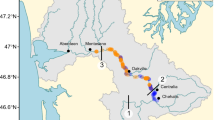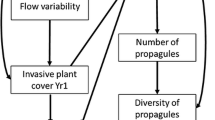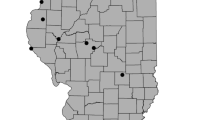Abstract
Invasive cattails (Typha angustifolia and Typha × glauca) pose a problem for many Laurentian Great Lakes wetlands, especially sedge/grass meadows. In western Lake Superior, early signs of invasion into sedge-dominated peatlands along the Kakagon and Bad Rivers, owned and managed by the Bad River Band of Lake Superior Chippewa, were noticed in the early 1990s. In 1998, we began tracking expansion of Typha patches and assessing causes and ramifications. Perimeters of patches were delineated with GPS, with repeat delineations in 2005 and 2013. At the Kakagon site, permanent transects were established tangential to the 1998 patch perimeters and perpendicular to those transects, extending into the cattails and outward into sedges. Plant communities were sampled along transects in all years. Transects across stands of non-invasive Typha latifolia were sampled for comparisons but showed little change. In 2005, area encompassed by the Kakagon River patches increased by 66% from 1998; increase was 143% by 2013. The Bad River patches increased by 25% in 2005; further analyses were not possible because some patches had coalesced. Across years, mean Importance Value (IV) for invasive Typha increased for all tangential and perpendicular transects, reflecting expansion into adjacent sedge meadow. Among changes in other species, mean IV for dominant sedge Carex lasiocarpa also decreased on both transects. Typha invasion seems to be directional and not cyclical in relation to lake-level changes, which might have future influence. Given the tendency for early Typha expansion, land managers should scout for new patches and begin treatment soon after discovery.






Similar content being viewed by others
Data Availability
All data produced from this study are provided in this manuscript.
References
Albert DA, Minc LD (2004) Plants as regional indicators of great lakes coastal wetland health. Aquat Ecosyst Health Manag 7:233–247
Albert DA, Wilcox DA, Ingram JW, Thompson TA (2005) Hydrogeomorphic classification for great lakes coastal wetlands. Journal of Great Lakes Research 31(Suppl 1):129–146
Argyilan EP, Forman SL, Johnston JW, Wilcox DA (2005) Optically stimulated luminescence dating of late Holocene raised strandplain sequences adjacent to southern Lake Superior, Upper Peninsula, Michigan, USA. Quaternary Research 63:122–135
Bansal S, Lishawa S, Newman S, Tangen B, Wilcox DA, Albert DA, Anteau M, Chimney M, Cressey R, DeKeyser S, Elgersma K, Finkelstein SA, Freeland J, Grosshans R, Klug P, Larkin D, Lawrence B, Linz G, Marburger J, Noe G, Otto C, Reo N, Richards J, Richardson CJ, Rogers L, Schrank A, Svedarsky D, Travis S, Tuchman N, van der Valk AG, Windham-Myers L (2019) Typha (cattail) invasion in north american wetlands: biology, regional problems, impacts, desired services, and management. Wetlands 39:645–684
Bedish JW (1967) Cattail moisture requirements and their significance to marsh management. The American Midland Naturalist 78:288–300
Boers AM, Veltman RLD, Zedler JB (2007) Typha × glauca dominance and extended hydroperiod constrain restoration of wetland diversity. Ecological Engineering 29:232–244
Boers AM, Zedler JB (2008) Stabilized water levels and Typha invasiveness. Wetlands 28:676–685
Carlson ML, Kowalski KP, Wilcox DA (2009) Promoting species establishment in a Phragmites-dominated great lakes coastal wetland. Natural Areas Journal 29:263–280
Ellison AM, Bedford BL (1995) Response of a wetland vascular plant community to disturbance: a simulation study. Ecological Applications 5:109–123
Epstein E, Smith W, Judziewicz E (1997) Priority wetland sites of Wisconsin’s Lake Superior basin. Wisconsin Department of Natural Resources - Bureau of Endangered Resources, Madison
Erickson S (2010) Cattail problems: hybrid cattail crowds out manoomin. Mazina’igan; a Chronicle of the Lake Superior Ojibwe. Eau Claire Company, Eau Claire, WI, p 5
Farrer EC, Goldberg DE (2009) Litter drives ecosystem and plant community changes in cattail invasion. Ecological Applications 19:398–412
Fitzpatrick FA, Dantoin ED, Tillison N, Watson KM, Waschbusch RJ, Blount JD (2017) Flood of July 2016 in Northern Wisconsin and the Bad River Reservation. U.S. Geological Survey Scientific Investigations Report 2017–5029. https://doi.org/10.3133/sir20175029
Freeland J, Ciotir C, Kirk H (2013) Regional differences in the abundance of native, introduced, and hybrid Typha spp. in northeastern North America influence wetland invasions. Biological Invasions 15:2651–2665
Frieswyk CB, Zedler JB (2007) Vegetation change in great lakes coastal wetlands: deviation from the historical cycle. Journal of Great Lakes Research 33:366–380
Galatowitsch SM, Anderson NO, Ascher PD (1999) Invasiveness in wetland plants in temperate North America. Wetlands 19:733–755
Gathman JP, Albert DA, Burton TM (2005) Rapid plant community response to a water level peak in northern Lake Huron coastal wetlands. Journal of Great Lakes Research 31(Suppl 1):160–170
Grace JB, Harrison JS (1986) The biology of Canadian weeds.: 73. Typha latifolia L., Typha angustifolia L. and Typha × glauca Godr. Canadian Journal of Plant Sciences 66:361–379
Harris SW, Marshall WH (1963) Ecology of water-level manipulations on a northern marsh. Ecology 44:331–343
Johnston JW, Argyilan EP, Thompson TA, Baedke SJ, Lepper K, Wilcox DA, Forman SL (2012) A sault-outlet-referenced mid- to late-holocene paleohydrograph for Lake Superior constructed from strandplains of beach ridges. Canadian Journal of Earth Sciences 49:1263–1279
Johnston JW, Thompson TA, Wilcox DA (2014) Paleohydrographic reconstructions from strandplains of beach ridges in the Laurentian Great Lakes. In: Martini IP, Wanless HR (eds) Sedimentary Coastal Zones from High to Low Latitudes: Similarities and Differences. Geological Society, London, UK. Special Publication 388, pp 213–228
Keddy PA (2010) Wetland Ecology: principals and conservation, second. Cambridge University Press, Cambridge
Keddy PA, Reznicek AA (1986) Great lakes vegetation dynamics: the role of fluctuating water levels and buried seeds. Journal of Great Lakes Research 12:25–36
Kercher SM, Zedler JB (2004) Flood tolerance in wetland angiosperms: a comparison of invasive and noninvasive species. Aquatic Botany 80:89–102
Kirk H, Connolly C, Freeland JR (2011) Molecular genetic data reveal hybridization between Typha angustifolia and Typha latifolia across a broad spatial scale in eastern North America. Aquatic Botany 95:189–193
Larkin DJ, Freyman MJ, Lishawa SC, Geddes P, Tuchman NC (2012) Mechanisms of dominance by the invasive hybrid cattail Typha × glauca Biological Invasions 14:65–77
Lishawa SC, Albert DA, Tuchman NC (2010) Water-level decline promotes Typha × glauca establishment and vegetation change in great lakes coastal wetlands. Wetlands 30:1085–1096
McCune B, Mefford MJ (2016) PC-ORD: multivariate analysis of ecological data. Version 7. MjM Software Design, Gleneden Beach
McDonald ME (1955) Cause and effects of a die-off of emergent vegetation. J Wildl Manage 19:24–35
Meeker J (1998) Wetlands of Long Island, Apostle Islands National Lakeshore. Report to the Apostle Island National Lakeshore, Bayfield
Meeker J, Fewless G (2008) Change in Wisconsin’s coastal wetlands. In: Waller D, Rooney T (eds) Vanishing Present, Wisconsin’s changing Lands, Water, and Wildlife. University of Chicago Press, Chicago, pp 183–192
Mitchell ME, Lishawa SC, Geddes P, Larkin DJ, Treering D, Tuchman NC (2011) Time-dependent impacts of cattail invasion in a great lakes coastal wetland complex. Wetlands 31:1143–1149
Odum EP (1971) Fundamentals of ecology, 3rd edn. W.B. Saunders, Philadelphia
Pieper S, Dorken M, Freeland J (2020) Genetic structure of hybrids and progenitors provides insight into processes underlying an invasive cattail (Typha × glauca) hybrid zone. Heredity 124:714–725
Pieper SJ, Nicholls AA, Freeland JR, Dorken ME (2017) Asymmetric hybridization in cattails (Typha spp.) and its implications for the evolutionary maintenance of native Typha latifolia The Journal of Heredity 108:479–487
Quinlan C, Mulamoottil G (1987) The effects of water-level fluctuations on three Lake Ontario shoreline marshes. Canadian Water Resources Journal 12:64–77
Seabloom EW, Moloney KA, van der Valk AG (2001) Constraints on the establishment of plants along a fluctuating water-depth gradient. Ecology 82:2216–2232
Shay JM, de Geus PMJ, Ka**a MRM (1999) Changes in shoreline vegetation over a 50-year period in the Delta Marsh, Manitoba in response to water levels. Wetlands 19:413–425
Smith IM, Fiorino GE, Grabas GP, Wilcox DA (2021) Wetland vegetation response to record-high Lake Ontario water levels. Journal of Great Lakes Research 47:160–167
Squires L, van der Valk AG (1992) Water-depth tolerances of the dominant emergent macrophytes of the Delta Marsh, Manitoba. Canadian Journal of Botany 70:1860–1867
Stewart D (2021) Undetected but widespread: the cryptic invasion of non-native cattail (Typha) in the Fraser River Estuary. Ph.D. dissertation, University of British Columbia, Vancouver
Swink F, Wilhelm G (1979) Plants of the Chicago Region. The Morton Arboretum, Lisle
Tangen BA, Bansal S, Freeland JR, Travis SE, Wasko JD, McGonigle TP, Goldsborough LG, Gow K, Marburger JE, Meier JA (2022) Distributions of native and invasive Typha (cattail) throughout the Prairie Pothole Region of North America. Wetlands Ecology and Management 30:1–17
Thiet RK (2002) Diversity comparisons between diked and undiked coastal freshwater marshes on Lake Erie during a high-water year. Journal of Great Lakes Research 28:285–298
Travis SE, Marburger JE, Windels S, Kubátová B (2010) Hybridization dynamics of invasive cattail (Typhaceae) stands in the Western Great Lakes Region of North America: a molecular analysis. Journal of Ecology 98:7–16
Travis SE, Marburger JE, Windels SK, Kubátová B (2011) Clonal structure of invasive cattail (Typhaceae) stands in the upper midwest region of the US. Wetlands 31:221–222
Tuchman NC, Larkin DJ, Geddes P, Wildova R, Jankowski K, Goldberg DE (2009) Patterns of environmental change associated with Typha × glauca invasion in a great lakes coastal wetland. Wetlands 29:964–975
Tulbure MG, Johnston CA, Auger DL (2007) Rapid invasion of a great lakes coastal wetland by non-native Phragmites australis and Typha Journal of Great Lakes Research 33(Suppl 3):269–279
Vaccaro LE, Bedford BL, Johnston CA (2009) Litter accumulation promotes dominance of invasive species of cattails (Typha spp.) in Lake Ontario wetlands. Wetlands 29:1036–1048
van der Valk AG, Davis CB (1978) The role of seed banks in the vegetation dynamics of prairie glacial marshes. Ecology 59:322–335
Voss EG, Reznicek AA (2012) Field manual of Michigan Flora. University of Michigan Press, Ann Arbor
Waters I, Shay JM (1990) A field study of the morphometric response of Typha glauca shoots to a water depth gradient. Canadian Journal of Botany 68:2339–2343
Waters I, Shay JM (1992) Effect of water depth on population parameters of a Typha glauca stand. Canadian Journal of Botany 70:349–351
Wilcox DA (2004) Implications of hydrologic variability on the succession of plants in great lakes wetlands. Aquatic Ecosystem Health & Management 7:223–232
Wilcox DA (2012) Response of wetland vegetation to the post-1986 decrease in Lake St. Clair water levels: seed-bank emergence and beginnings of the Phragmites australis invasion. Journal of Great Lakes Research 38:270–277
Wilcox DA, Apfelbaum SI, Hiebert RD (1984) Cattail invasion of sedge meadows following hydrologic disturbance in the Cowles Bog Wetland Complex, Indiana Dunes National Lakeshore. Wetlands 4:115–128
Wilcox DA, Bateman JA (2018) Photointerpretation analysis of plant communities in Lake Ontario wetlands following 65 years of lake-level regulation. Journal of Great Lakes Research 44:1306–1313
Wilcox DA, Bateman JA, Kowalski KP, Meeker JE, Dunn N (2022) Extent of sedge-grass meadow in a Lake Michigan drowned river mouth wetland dictated by topography and lake level. Wetlands 42:34
Wilcox DA, Buckler K, Czayka A (2018) Controlling cattail invasion in sedge/grassmeadows. Wetlands 38:337–347
Wilcox DA, Kowalski KP, Hoare HL, Carlson ML, Morgan HN (2008) Cattail invasion of sedge/grass meadows in Lake Ontario: photointerpretation analysis of sixteen wetlands over five decades. Journal of Great Lakes Research 34:301–323
Wilcox D, Nichols SJ (2008) The effect of water-level fluctuations on plant zonation in a Saginaw Bay, Lake Huron wetland. Wetlands 28:487–501
Woo I, Zedler JB (2002) Can nutrients alone shift a sedge meadow towards dominance by the invasive Typha × glauca? Wetlands 22:509–521
Acknowledgements
Funding for fieldwork in 1998, 2005, and 2013 was provided by the Bad River Band of Lake Superior Chippewa to J. Meeker (and S. Johnson co-PI in 2013). Staff of the Bad River Band that provided logistical support include E. Soulier and J. Strand. The Band’s seasonal staff provided boat transportation and guide support. Dale Soltis and Jeremy Ridlbauer assisted in the 1998 field sampling, V. Hofman shared sampling in 2005, and J. Elias and M. Hogfeldt helped sample in 2013. T. King generated the GIS figures in 2005, and J. Mead generated the GIS figures and conducted spatial analysis in 2013. Manuscript figures were created with assistance from A. Graham and G. Lawrence. We thank R. Schultz for a helpful review of a draft of the manuscript. We also thank Joan Elias for accessing and providing some data sets that were determined to be necessary during preparation of this paper after the passing of her husband, senior author Jim Meeker. The scientific community, especially wetland scientists in the Great Lakes, suffered a great loss when this kind, passionate, and insightful naturalist was taken from us.
Funding
Funding for fieldwork in 1998, 2005, and 2013 was provided by the Bad River Band of Lake Superior Chippewa.
Author information
Authors and Affiliations
Contributions
Meeker and Wilcox conceived study. Meeker and Johnson conducted data collection and did data analyses. Tillison provided critical site information and coordinated field efforts. Wilcox wrote much of the manuscript with assistance from other authors on selected parts.
Corresponding author
Ethics declarations
Ethics Approval
Not applicable.
Consent to Participate
Not applicable.
Consent for Publication
Consent provided by Mike Wiggins, Chairman, Bad River Band of Lake Superior Chippewa.
Conflicts of Interest/Competing Interests
Not applicable.
Additional information
Publisher’s Note
Springer Nature remains neutral with regard to jurisdictional claims in published maps and institutional affiliations.
James E. Meeker is deceased.
Rights and permissions
Springer Nature or its licensor (e.g. a society or other partner) holds exclusive rights to this article under a publishing agreement with the author(s) or other rightsholder(s); author self-archiving of the accepted manuscript version of this article is solely governed by the terms of such publishing agreement and applicable law.
About this article
Cite this article
Meeker, J.E., Wilcox, D.A., Johnson, S.E. et al. Tracking Vegetation Transitions Due to Invasion of Cattail (Typha) in Lake Superior Coastal Peatlands. Wetlands 43, 18 (2023). https://doi.org/10.1007/s13157-023-01664-9
Received:
Accepted:
Published:
DOI: https://doi.org/10.1007/s13157-023-01664-9




